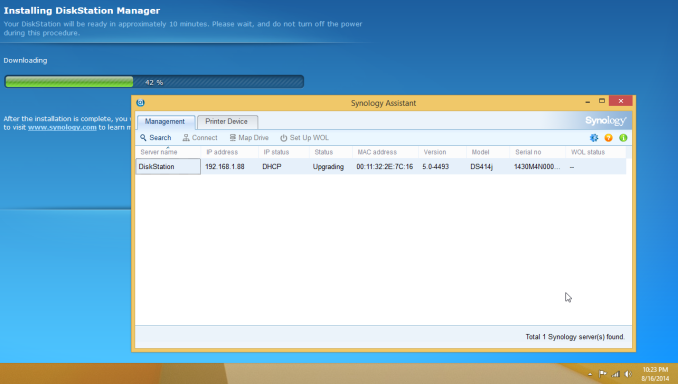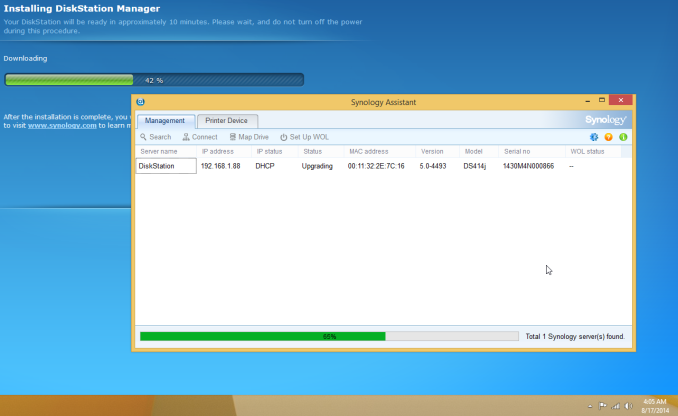Recovering Data from a Failed Synology NAS
by Ganesh T S on August 22, 2014 6:00 AM ESTDS414j Status: Disk Problems or Hardware Failure?
After ensuring the safety of the data, I tried to reinitialize the NAS using the same drives, but the process conked out towards the end with a message indicating that the process was incomplete and telnet service had been enabled for support personnel to look into. Not satisfied with this situation, I rebooted the unit with the drives removed and the reset button at the back pushed in. After the reboot, I inserted two fresh drives and began the initialization process.
DSM Initialization Process 3 Hours After Starting
DSM Initialization Process More than 8 Hours After Starting
The completion process was stuck at 42% with the second drive's LED blinking continuously for more than 48 hours before I pulled the plug. Synology Assistant had shown the status of the unit as 'Upgrading' the whole time.
Synology support asked me to try initializing with a single drive (completely new, fresh out of the box) in another bay. This changed the failure symptom, but didn't resolve the issue.
The unit was shipped back to Synology and they found that one of the circuit board elements had simply died (no burn-out or any other marks). So, it did turn out to be an internal hardware failure in the end. A small percentage of products shipped by any vendor invariably fails in the early stages of being in the consumer's hands. It was just unfortunate for Synology that it happened to a review unit sampled to the press.













55 Comments
View All Comments
Lerianis - Friday, September 5, 2014 - link
Links to the articles supporting that please.YoshoMasaki - Monday, August 25, 2014 - link
Hi there, I was wondering if you would recommend "Windows Server 2012 R2 Essentials with Update x64" as a home server for backups? I can get this for free through Dreamspark (https://www.dreamspark.com/Product/Product.aspx?pr... but I have never used WHS before and I'm a little intimidated by it. Reading "Windows Server 2012 R2 Essentials ... continues to have the requirement that it must be an Active Directory domain controller and that it must be the root of the forest and domain" (Source here: http://winsupersite.com/windows-server-2012/window... makes me think I'm in over my head, but I REALLY get lost when folks here talk Linux/Unix file systems and custom RAID stuff with a half-dozen drives. I'm a Windows guy for 20+ years now so I think I can learn it but I wonder if it'd be worth it. Thanks for your input.YoshoMasaki - Monday, August 25, 2014 - link
Post above ate my links ... please remove the parenthesis from the end or click here:https://www.dreamspark.com/Product/Product.aspx?pr...
http://winsupersite.com/windows-server-2012/window...
fatbong - Monday, August 25, 2014 - link
Completely agree. I wish there was a NAS available which used NTFS and simple disk mirroring. It would make data recovery extremely easy, if the NAS were to suffer hardware failure. I have an aging Buffalo Linkstation Quad, and hardware failure worries me. Is there any NAS out there which uses NTFS ? And no, I dont want to build/buy a server. I want an appliance.Stylex - Thursday, August 28, 2014 - link
Yeah, I migrated from WHS 2003 to Win8 with DriveBender, similar to Drivepool. Love that if it goes sideways all my stuff is NTFS. I don't have time or stress levels to deal with linux command line stuff to get it working again.BD2003 - Friday, August 22, 2014 - link
I recently decided to drop my home NAS (synology ds212j), since I no longer have multiple PCs...and getting that data off was a nightmare. It had a backup drive that was formatted in ext4, since synology didn't support incremental backups to NTFS.Because of the way it stored the incremental backup, it was basically useless for reading directly through an ext driver for windows. I had to completely wipe the backup drive and reformat it in NTFS to make a one time backup, and cross my fingers that I didn't lose a drive during the damn near 24 hour process (thanks to the hyper fragmented NAS drives, barely adequate NAS CPU and USB 2.0.) Then I had to pull the drives, reformat them, and pray the backup worked. Then transfer everything back. This process literally took days.
If it was a windows based box, I could have just pulled the drives, dropped them in the PC and been done with it in 5 minutes, without even rebooting. I probably would have never even dropped the NAS, since I could upgrade it without having to migrate anything.
Basically the entire experience put me off of ever using a Linux based NAS ever again. Between the file system incompatibility and the potential for RAID array failure....it's just not worth it. My data has never felt so unsafe than during that process.
dabotsonline - Friday, August 22, 2014 - link
"In the end, I decided to go with a portable installed system, which, unlike a persistent install, can be upgraded / updated without issues. I used a Corsair Voyager GT USB 3.0 128 GB thumb drive to create a 'Ubuntu-to-go' portable installation in which I installed mdadm and lvm2 manually."Even though it wasn't specified in the Synology FAQ, wouldn't a portable installation of Parted Magic or SystemRescueCd work OK?
Christobevii3 - Friday, August 22, 2014 - link
From my experience with my synology 413j for a while I've learned a few things:First: Turn on the smart disk check to run weekly, otherwise if you never restart the device you won't have a hint of failure coming.
Second: 5TB usb's are cheap, setup a backup task to these.
Third: UPS. Always run a ups. A $50 apc is enough and will hold the device up for a while and allow it to shutdown properly in a power outage.
Last: If you have a disk failure it locks up the device. You will probably be able to detect which disk it is by pulling one at a time. When you get the proper one it will be accessible and you know which disk to replace.
jbm - Friday, August 22, 2014 - link
Very interesting article - have often asked myself what to do if my NAS ever should die a sudden death, because it's a bit old (Thecus 4200) and I probably would neither manage to buy another one nor want to (not because it is bad, just because I'd rather switch to something newer). More articles like this, please!Nogami - Saturday, August 23, 2014 - link
I'd be curious what exactly was the component that died - I've had yet another capacitor failure in the last week which took out an old LGA 775 motherboard (though it happily enabled an upgrade to an i7-4790K).All in all, the vast majority of hardware failures I've had in the last 5 years has been due to capacitor death, usually in power supplies, causing general flakyness, and eventually becoming terminal. I'm curious if that was the case here as well.